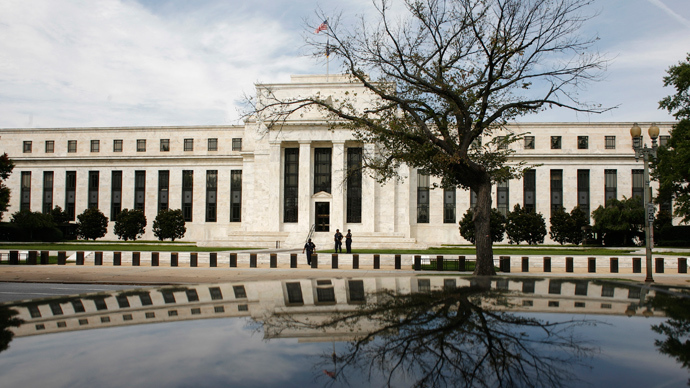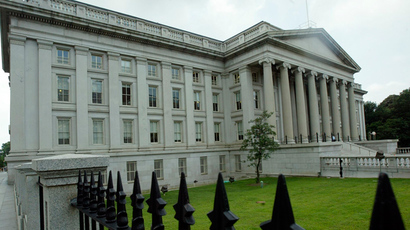America clings to $85bn lifeline, Fed keeps stimulus

In an unexpected move, the Federal Reserve decided not to put the brakes on its easy money policy, and will keep bond purchases at $85 billion per month.
Chairman Ben Bernanke said at the press conference after the
meeting that there is “no fixed schedule” or “magic
number” for when the Federal Reserve will begin to slow or
end its bond purchases.
The decision reached at the end of Wednesday’s two-day meeting of the Federal Open Market Committee (FOMC) came out of the blue, as Chairman Ben Bernanke gave strong hints in August and July that the Fed would decide to begin tapering its stimulus.
“What we will be looking at is the overall labor market
situation, including the unemployment rate but other factors as
well. There is no magic number,'' he said.
Bernanke clarified that the program will not necessarily end when
unemployment reaches seven percent.
With economic recovery still only slightly picking up, reducing the purchases, even by $10 billion, would have risked wiping out the success achieved in the last four years, and a possible return to dangerous industry bubbles and high inflation.To counter this threat, the Fed will keep official interest rates low.
Unemployment, currently at 7.3 percent, is at its lowest since 2008, but it isn’t clear if the record-low rate is a reflection of robust recovery or cyclical. Inflation is still running below the Fed’s 2 percent target.
“We expect them to finish tapering in March, in time for the unemployment rate to fall below 7 percent," Societe General currency strategist Kit Juckles wrote in a note to clients before the decision was announced.
Forecast growth for 2013 is between 2.3 and 2.8 percent, but real growth is closer to 1.8 percent for the first half of 2013. Growth is sluggish, but much more robust compared to the EU, which posted 0.3 percent growth for Q2.
The decision coincides with the 5-year anniversary of the
collapse of Lehman Brothers, and the financial collapse that
prompted the Fed to pump the economy with over $3.5 trillion in
bond purchases and a cut in overnight rates to zero.
Choosing to keep the bond purchases at $85 billion of cash
injection per-month, split as $40 billion mbs and $45 billion
treasuries, comes before President Obama takes on the Republicans
in negotiations over raising the debt-ceiling, which he plans to
boost in mid-October once the US hits its spending limit. The
government has amassed $16.7 trillion in debt. The deadline for
extension is November 2.
If Congress doesn’t extend the debt ceiling, the US could be forced to default on debt and the government could shut down, an option Obama has sworn against.
Global reach
This afternoon’s decision has market implications that reach far beyond America’s shores.
BREAKING: Dow Jones industrial average hits record after Fed keeps stimulus in place; Bonds, gold rise.
— The Associated Press (@AP) September 18, 2013
Though following the decision stock rose sharply, ahead of it emerging markets tumbled, worried America's cuts could have drastic spillover effects. Billions fled emerging markets on the expectation dollar-based investments would yield higher returns after the probable cuts.
“Emerging markets are backing off, and I really think we will
have a poor year in 2014. The good news is if we have
another year or 2 of slowed growth, we may be a in a stronger
position for more robust recovery at a later stage, looking at
2017 or 2018,” Lars Christensen, CEO at Saxo Bank told RT in
an interview.
“I think the economy will weaken again, relatively soon, we will have maybe one more quarter of rising equity markets and then we’ll hit a top and back off again,” Christensen concluded.
Summer's over
Bernanke’s departure as Chairman in January 2014 had been
expected to ‘rush’ the Fed’s decision to start winding-down under
Bernanke’s tenure instead of waiting for a new head.
Leading candidate, and Obama-favorite Larry Summers, withdrew his name for consideration on Sunday,
leaving Janet Yellin, 67, the moderate vice chairwoman of the
central bank, as the likely successor.
A Yellin decision is seen as a safer, smoother, move to Summers,
as colleagues fear he would have dismantled the stimulus too
quickly and aggressively. Asian markets advanced on Summer’s
exit, as the cash-cut off could have a nasty spill over effect on
emerging markets.
Yellin, who chaired the White House Council of Economic Advisers
under the Clinton administration, would be the first woman to
head the Federal Reserve.














